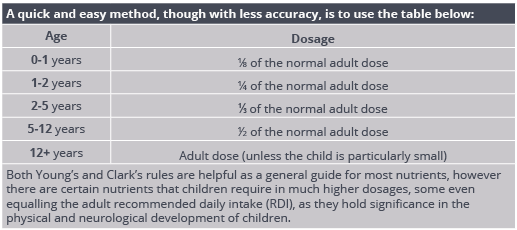Determining the correct dose of nutrients and supplements for children can be overwhelming. Each child is unique and will require their own individual dose, which will be dependent on factors such as dietary intake, level of physical activity, amount of mental stress, time spent outdoors and genetic single nucleotide polymorphisms (SNPs). It’s a delicate balance finding that correct dosage, ensuring we avoid deficiency yet prevent toxicity. To add to the confusion, many supplements will only show an adult dose on the label. So how can we convert that to a dose suitable for children? Two ways of doing so are Young’s rule and Clark’s rule.



Children have a substantial requirement for calcium due to their rapid rate of growth. Alongside bone and teeth formation, calcium is needed for optimal muscle contractions, nerve conduction, heartbeat, hormone release and enzyme regulation.[1] When considering calcium dosages for a child, using Clark’s or Young’s rule would not provide an adequate dosage as the suggested RDI and upper limit (UL) of calcium for children is on par with the suggested adult intake (ranging from 500mg per day in one to three year olds, to 1.3g per day in 14-18 year olds, and 1-1.3g per day in adults).[2] The RDI of calcium for a nine year old is the same as for an adult, 1g. The UL of calcium is the same for all ages, from one year’s old through to adulthood; 2.5g per day.[2]
Zinc is vital for children, and when we look at the suggested RDI and UL, we can see how an infant’s zinc requirement is not much less than that of an eight year old child (3mg per day and 4mg per day, respectively).[2] When we look at the significant role that zinc plays in brain development, we understand how vital it is to ensure adequate zinc levels in the growing child. The highest levels of zinc are found in the hippocampus; it is necessary for synaptic transmission, neurogenesis, brain tubulin growth and phosphorylation.[3]
Zinc is also a major player in neurotransmitter production, immunity (including white blood cell proliferation)[4] and gastrointestinal epithelial cells.[5] A deficiency of zinc may result in lowered learning ability, apathy, lethargy, mental and growth retardation, immunodeficiency, behavioural issues, poor appetite and abnormal sexual development.[3] The scale for zinc dosage in children ranges from 3mg per day through to 25mg per day.[2]
Another nutrient that children require in a higher quantity is iron as it is imperative for optimal development. When we think of iron, we think of its role in the transportation of oxygen via production of haemoglobin.[6] Iron is a player in the cognitive development of children and also largely features in immune health and physical growth.[1,7] Children (of all ages) require as much or more iron than an adult male (8-15mg per day and 8mg per day, respectively), and if clinically indicated, can take up to the same dosage per day of a menstruating female (18mg per day).[2]
Magnesium is a nutrient required in high amounts for most individuals, and children are no exception, with an RDI ranging from 80mg per day for one to three year olds to 410mg per day in 14-18 year old boys.[2] With magnesium involved in over 300 enzyme reactions in the body, failing to consume the RDI on a regular basis will adversely affect these enzyme systems and have a flow on effect throughout the entire body. One of magnesium’s functions is the conversion of vitamin D into its active form. Failure of this may then affect calcium absorption and utilisation, thus affecting bone growth and development.[8] Magnesium is a gamma-aminobutyric acid (GABA) agonist, so it can reduce agitation, irritability, hyperexcitability and aggression in children.[9] Children will have a higher demand for magnesium when experiencing physical or emotional stress. Magnesium is found in highest concentrations in green leafy vegetables, cacao, nuts, seeds, legumes and whole grains.[1]
The role of vitamin D in calcium homeostasis and bone development has been mentioned previously. Vitamin D also has a crucial role in immunomodulation, as well as brain development and behaviour.[1,10] The recommended AI and UL for children is equal to that of an adult (an RDI of 5mcg per day for all age groups, bar those in the 51-70 age group who need 10mcg per day, with a UL of 80mcg per day), indicating that age and size does not discriminate the need of this vital nutrient. It has been recommended by experts in the field of vitamin D research that healthy children receive approximately 1000IU (25mcg) per 11kg of body weight each day to achieve optimal vitamin D levels year round.[10]
It should be noted that all nutrients play a vital and intricate role in children’s health and development. The purpose of this article was to highlight the increased dosage requirements of selected nutrients and to help give understanding of how to correctly dose supplements when required in children to ensure healthy development through to their adult years.
References
- Braun L, Cohen M. Herbs and natural supplements: an evidence-based guide, 4th ed. Sydney: Churchill Livingstone Elsevier, 2015. [Source]
- Calcium, zinc, iron, magnesium, vitamin D. Nutrient reference values, https://www.nrv.gov.au/nutrients
- Pfeiffer CC Braverman ER. Zinc, the brain and behaviour. Biol Psychiatry 1982;17(4):513-532. [Abstract]
- Prasad AS. Zinc in human health: effect of zinc on immune cells. Mol Med 2008;14(5-6):353-357. [Full text]
- Skrovanek S, DiGuilio K, Bailey R, et al. Zinc and gastrointestinal disease. World J Gastrointest Pathophysiol 2014;5(4):496-513. [Full text]
- Abbaspour N, Hurrell R, Kelishadi R. Review on iron and its importance for human health. J Res Med Sci 2014;19(2):164-174. [Full text]
- World Health Organization. Nutritional anaemias: tools for effective prevention and control, 2017. Geneva: World Health Organization. [Full text]
- Schwalfenberg GK, Genuis SJ. The importance of magnesium in clinical healthcare. Scientifica 2017:4179326. [Full text]
- Black LJ, Allen KL, Jacoby P, et al. Low dietary intake of magnesium is associated with increased externalising behaviours in adolescents. Public Health Nutr 2015;18(10):1824-1830. [Full text]
- Weydert JA. Vitamin D in children’s health. Children (Basel) 2014;1(2):208-226. [Full text]
DISCLAIMER:
The information provided on FX Medicine is for educational and informational purposes only. The information provided on this site is not, nor is it intended to be, a substitute for professional advice or care. Please seek the advice of a qualified health care professional in the event something you have read here raises questions or concerns regarding your health.



